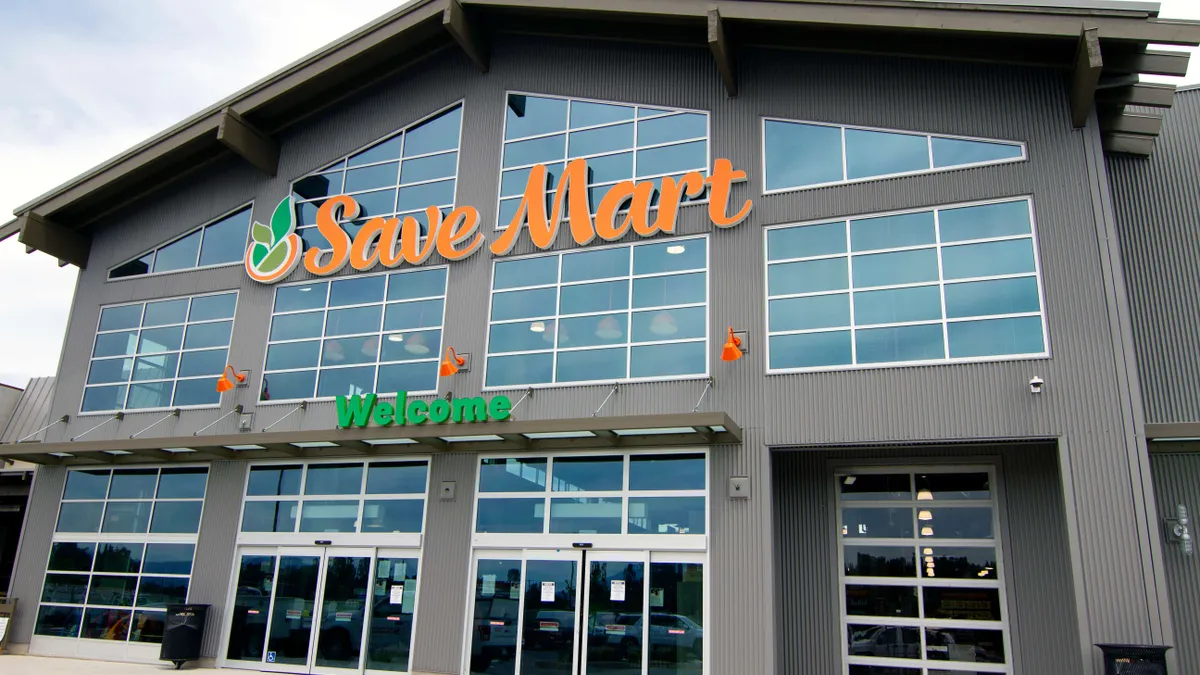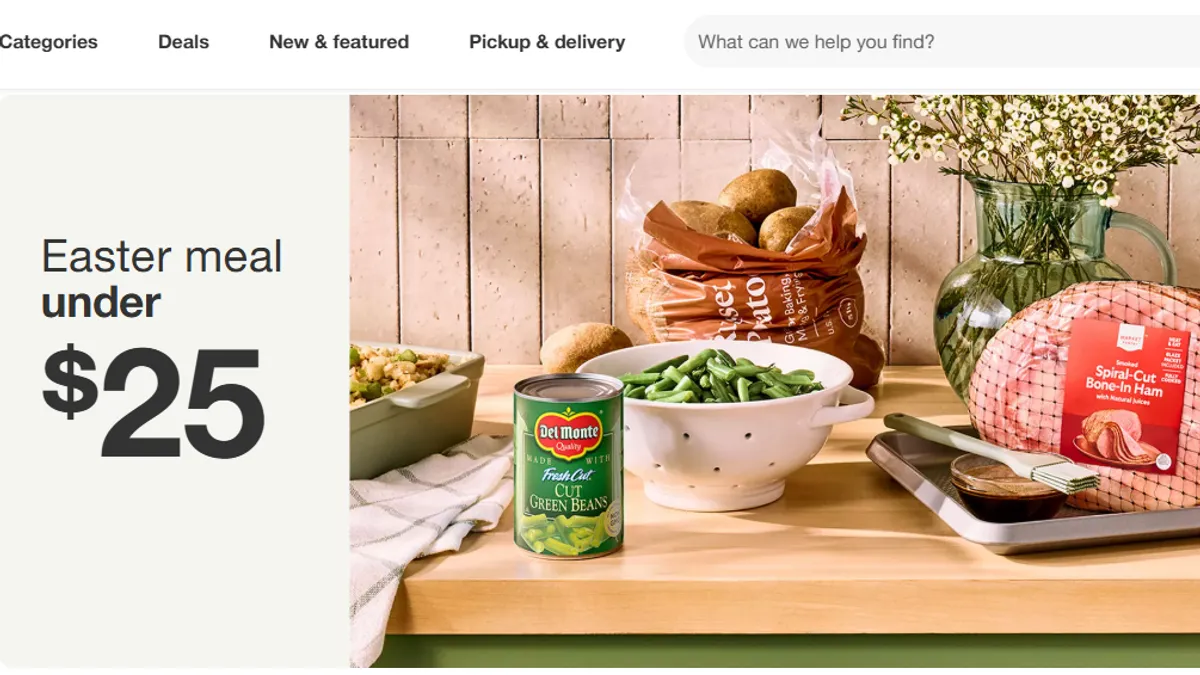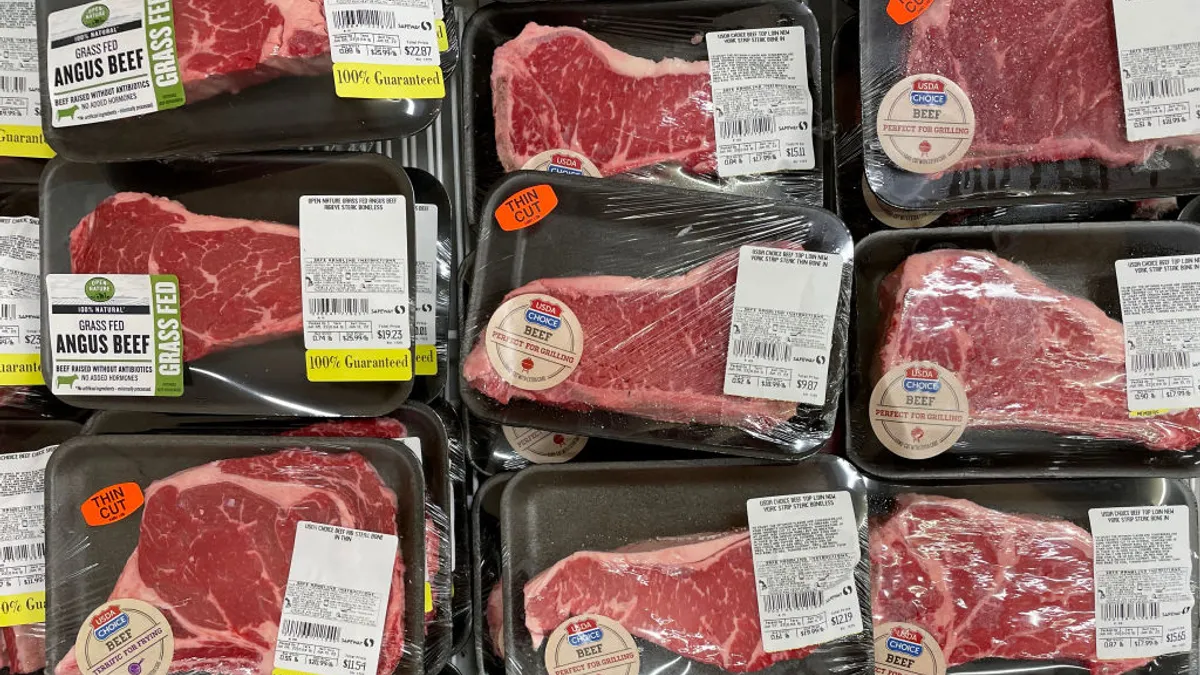UPDATE: March 5, 2019: This story has been updated to reflect comments from Target provided after the story was published.
Target has long been a mass retailer of choice for home furnishings, fun fashion finds and household essentials. The sense of adventure and discovery the company promotes has created the infamous "Target run," where consumers go for one or two items and end up leaving with more than $100 in merchandise.
The retailer's grocery department, on the other hand, isn't always part of the fun.
"It’s not really seen by consumers as a proper grocery store," Neil Saunders, managing director of GlobalData Retail, told Grocery Dive. "They invariably use it not at all, or to top off shopping when they buy other things. Obviously in grocery that’s not ideal. You need to be a destination and you need to drive volume in order to succeed."
Target's grocery struggles began to surface in 2016, when grocery accounted for about 22% of its business but failed to produce comparable sales increases. After a couple rocky years, Target began to see a steady climb in its Food and Beverage category last year with the addition of more fresh and organic foods, a wider selection of alcohol and specialty products.
In its recent earnings announcement for Q4 2018, Target reported that it has continued to see strong growth across its business, including the Food and Beverage category.
"We’ve made tremendous progress in Food and Beverage over the last 18 months," said Joshua Thomas, a spokesperson for Target, in an email to Grocery Dive. "We’ve seen six straight quarters of [comparable] growth and have achieved market share gains across almost every category of food — and we’re confident in our ability to build on this progress moving forward."
The upward momentum signifies Target’s continued progress in the space. But given its strengths in other departments, does Target need to have a strong grocery offering in order to remain competitive? Saunders thinks so, as food and beverage plays a role in overall sales and helps drives traffic to the store. "A lot of other developments are happening in the grocery space and Target doesn’t want to be left behind. It’s got to be a key player in that business," Saunders said.
Target has made some interesting efforts in grocery, carrying innovative brands, private label products and emerging product categories such as plant-based food, said Tory Gundelach, an analyst with Kantar Consulting. Still, its unclear grocery strategy makes it difficult for consumers to know how to fit its aisles of cereal, frozen foods, produce and Archer Farms store brand products into their regular shopping patterns.
"It’s hard to know what they’re trying to do [in grocery] beyond driving traffic..." Gundelach told Grocery Dive. “I think they’re aware of that and they have to figure out what exactly they want to stand for in the industry.”
“A lot of other developments are happening in the grocery space and Target doesn’t want to be left behind. It’s got to be a key player in that business.”

Neil Saunders
Managing director, GlobalData Retail
Thomas said that Food and Beverage is an incredibly important part of the company’s assortment. "It is a big frequency driver for Target and like our other merchandise categories, it is critical that our approach to food — from selection to presentation — brings joy and inspiration to our guests’ everyday lives," he said.
Target has been vocal about its recent emphasis on home furnishings, apparel and other categories over grocery in recent months as the retailer tries to earn back its “Tar-Jay” reputation after a post-recession sales slowdown. CEO Brian Cornell has committed a $7 billion investment through 2020 to help the company restore its image, but has not been specific about where grocery falls into Target's priorities.
Gundelach said that Target has been working to reinvigorate its core business over the past 18 months, putting a lot of attention on relaunching brands in home and apparel and moving into more unique brands in the beauty and personal care space. Grocery, on the other hand, isn’t necessarily broken, and its development as a category is a progression, she said. Target's focus on niche product assortment and ability to offer low pricing are notable strengths for the grocer.
"I give them credit for acknowledging they can’t reinvent their whole store at the same time," Gundelach said.
Recent moves may boost grocery
In January, Target announced the promotion of Stephanie Lundquist to the position of president of food and beverage, indicating the retailer may be shifting its focus. In a recent blog post, Lundquist noted the "incredible progress" that Target has made in the food and beverage space, also saying that there is more the company can do. She alluded to changes coming that will cover brand development, customer experience and plans to propel the business forward in the future, but didn't offer any specifics.
"By bringing the full spectrum of Food and Beverage merchandising and operations together as one team under a dedicated leader, we’re positioned to better harness the expertise of each business area and streamline the work to accelerate our progress," Thomas said.
It’s too early to tell how this new executive role will play out, but it is a promising move for the retailer, Saunders noted.
"I think the appointment is significant," he said. "It suggests that Target is getting more serious about its food and beverage offer and that it wants to have a more coordinated strategy to take it forward over the next few years."
In Target's third-quarter earnings call for 2018, executives touched on the company’s efforts in food and beverage, noting that comp sales for the category grew around 4% for the quarter ending in October 2018.
"Within the category, we saw strong, encouraging results in our own brand assortment, along with double-digit comps again in adult beverage," said Mark Tritton, Target’s chief merchandising officer, on the call.
The company has embarked on a series of store remodels and a new format that could strengthen the perception of Target as a grocery destination. Last summer Target announced plans to remodel 1,000 stores over the course of three years to simplify e-commerce fulfillment and make the in-store experience easier for shoppers. Expanded grocery departments have been reported at some of the remodeled stores, including more grab-and-go grocery items, refreshed produce bins and improved grocery display.
Target also launched small-format stores last year, with a goal of opening 130 by the end of this year. Grocery plays a key role in these stores. In Target’s 26,000 square foot, small format store in Falls Church, Virginia, for example, about 25% of the store is dedicated to grocery and offerings include fresh produce, meat and dairy, and shelf-stable items such as cereal, pasta and snacks. Other stores have followed suit, and Target said that the assortment in these smaller stores will be specially curated for local shoppers.
Product assortment and private label offerings are a key ingredient to grocery success, and Target’s Market Pantry, Archer Farms and Simply Balanced brands make it competitive in this area. Target has continued to add new products like Archer Farms non-dairy ice cream, Market Pantry Sugar Cookie milk and a new line of private label wines. The company also recently introduced a discount household brand called Smartly.
Saunders said that Target’s brands are one of its biggest strengths in grocery. "Target has done a lot of things right, mostly with branding. People trust Target’s brand, and that’s a very positive thing."
When it comes to fresh food assortment, however, Target needs to improve, he said. There is a produce section and a limited fresh meat selection, but these departments are paltry compared to the fresh food offerings from other grocers, which boast large delis, prepared foods, in-house bakeries and more. Target has also been criticized for the subpar quality and selection of its produce department.
Saunders said Target's underperformance in fresh foods is holding the chain back. "That’s a shame, I think, because that’s a lot of what customers want now. Everything being packaged really degrades Target’s grocery offering," he said.
E-commerce hits the bullseye
One of Target’s most notable moves in recent history was the acquisition of Shipt, which strengthened its e-commerce capabilities across categories, including grocery.
When Target purchased Shipt in 2017, the grocery business was just 15% the size of Walmart’s, according to Moody's analysis cited by Business Insider. Since the purchase, Target has continued to expand its online grocery services, rolling out both grocery delivery and curbside pickup to more cities.
According to a report from CommonSense Robotics that cited data from Deutsche Bank, Target is one of just two major retailers, the other being Amazon, that is prioritizing same-day grocery delivery. Same-day delivery through Shipt is now available in 250 markets at more than 1,400 Target stores nationwide, said John Mulligan, Target's chief operating officer, on Target’s last earnings call. Some Shipt orders can be delivered in two hours or less.
Additionally, Target’s Drive Up service is now available in 1,000 stores, and online orders that are picked up at stores increased 60% year over year in December.
While e-commerce applies to more than just its grocery offering, as Target works to improve in the category, it is well-positioned to compete with dominant players like Walmart and Kroger who are strong in grocery and e-commerce. Target recently announced that it would expand the selection of products available through Shipt this year, making more than 55,000 products available to customers in grocery and other categories.
Gundelach said that no retailer in the U.S. has completely figured out the online grocery model at this point, and that owning Shipt can help advance Target's efforts. "By buying Shipt, it allows Target to still be in that race...not in front, but they're in it," she said.
How Target can elevate grocery
To move ahead in the grocery space, Target will need to clearly define its value proposition, Gundelach said.
"What do they want to stand for in this space?” she noted. "Do they want [customers] to fill in their shopping trip, or do they want to bring that cool factor into food and focus more on snacks and beverages? Right now they’re trying to go in the middle of those two things and that’s why they may be struggling, as they’re not clear what they’re offering."
According to Saunders, Target will succeed in grocery if the company elevates the grocery experience in-store. He said that while the grocery departments are functional, they are not very inspiring.
"It’s still not as good as it good be — it needs a lot more fresh produce, a lot more nuance in display to make it more attractive to customers," Saunders said. He also said that the presence of takeout vendors such as Starbucks and Pizza Hut detract from the grocery experience, and don’t do much to differentiate it or make it a grocery destination.
If Target has ambitions to win grocery dollars from its shoppers, the company has its work cut out. Based on recent moves, the retailer seems aware of the progress that needs to be made, taking a slow approach to build its grocery business while trying to maintain its broader success across retail. Whether its efforts are enough remains to be seen.





















